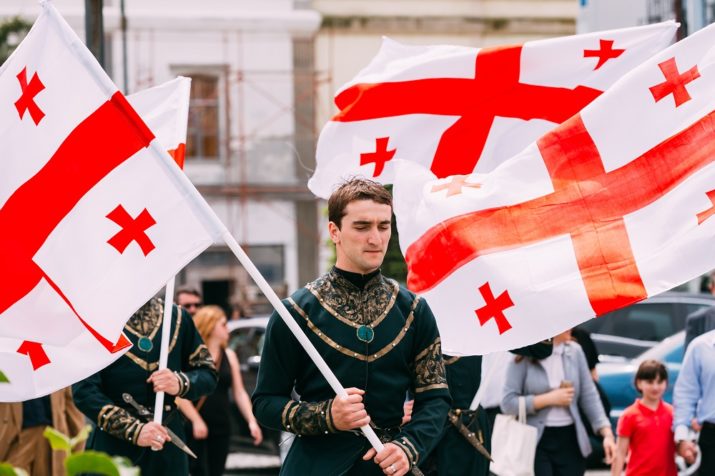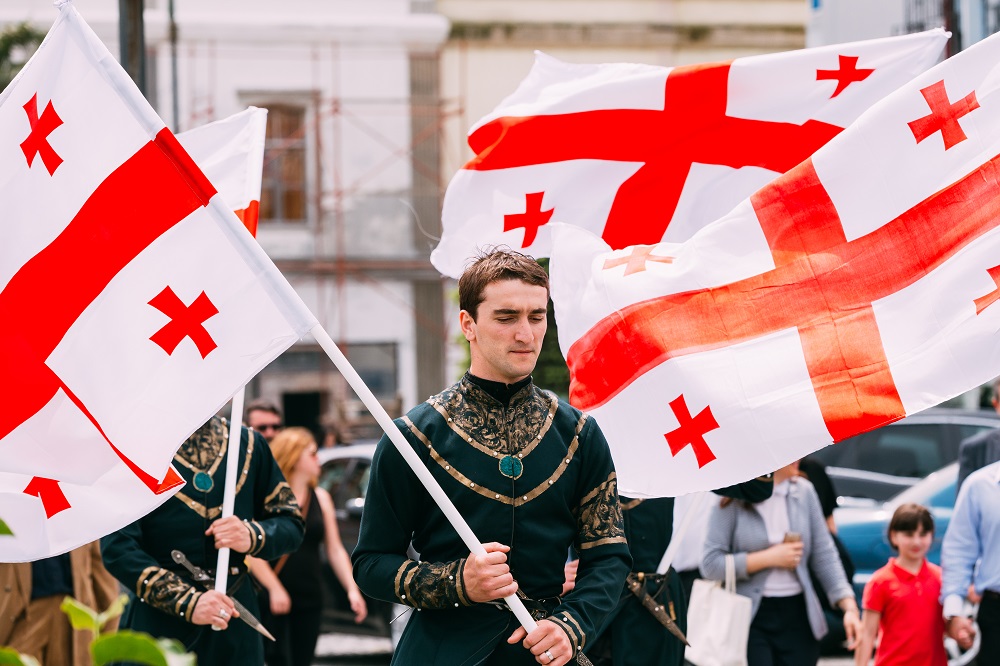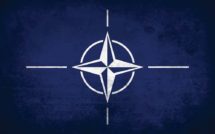

The Mensheviks are remembered, if at all, as the losers in the Russian Revolution. They were one of the two main factions in the Russian Social Democratic Party, the other being Lenin’s Bolsheviks. The day after the Bolsheviks staged their successful coup d’état in Petrograd in November 1917, Menshevik delegates walked out of the Congress of Soviets in protest. Trotsky famously called out after them, “You are miserable, isolated individuals!” “You are bankrupt. You have played out your role. Go where you belong: to the dustheap of history!” [1] He was, in a sense, correct. (Though it would turn out that Trotsky would, in a few short years, follow the Mensheviks into political exile and irrelevance.)
But in the remote border province of Georgia, the Mensheviks had a rather different fate from that of their Russian comrades. The Mensheviks had long been the dominant political party, with deep support among peasants, workers and intellectuals. They had real roots among the peasantry, where unusually the orthodox Marxists in Georgia were able to form strong connections. In the run-up to the 1905 Russian revolution, nearly all of western Georgia rose up in rebellion and was run as a separate state, free of Tsarist control, and became known as the “Gurian republic.” Though the region was eventually, and brutally, brought back under the control of the Russian state, the Menshevik links with the peasants remained strong. Some of the key Menshevik leaders, including Noe Zhordania, who would later serve as the Georgian president, and Noe Khomeriki, who was the architect of the agrarian reform, came from this region.
Unlike them, the Georgian Bolsheviks were a tiny, isolated band. Their most famous member, Joseph Stalin, chose to spend 1917 in Petrograd. As a result, from 1918 until 1921, the Georgian Mensheviks were able to test out their vision of democratic socialism in practice. While in Russia, the Bolsheviks quickly established one-party rule and a ruthless “dictatorship of the proletariat,” in Georgia, their Menshevik rivals created a multi-party democracy, with free elections and a free press. In those elections, the Mensheviks did exceptionally well, but non-socialist parties were also free to compete for power.
While the Russian Bolsheviks were clamping down on trade unions, which were dismissed by Trotsky as being under the control of “chatterboxes,” in Menshevik-led Georgia they thrived – retaining their independence from the state and winning a constitutional right to strike. They also played a key role in a remarkable institution known as the Wages Board, which consisted of ten representatives each from the employers and trade unions. This Board ensured that workers’ wages kept pace with inflation, and was in a sense a forerunner of the post-World War II social partnerships that became common in Western Europe. And while ordinary Russians suffered from the years of “war communism,” when armed detachments from the cities raided the countryside looking for food, in Georgia an ambitious agrarian reform was carried out that turned most peasants into land-owners for the first time. There was no famine, and no war between city and countryside.
Georgia was no paradise under Menshevik rule – but then again, the Mensheviks (unlike their Bolshevik rivals) never claimed to be creating one. Georgia remained a deeply poor and underdeveloped country. Ethnic divisions worsened, particularly between the majority Georgians and minorities like the Abkhazians and Ossetians. In their efforts to suppress ethnic separatism, some elements of the Georgian security forces, in particular members of the National Guard, a militia that was fiercely loyal to the Menshevik party, behaved badly. And still, the country’s record on human rights remained infinitely better than that of Soviet Russia, with its secret police, labor camps, and mass executions.
The Georgian experiment in democratic socialism ended abruptly when, at the end of the Russian civil war, Stalin and his cronies ordered an invasion of the country. The Georgians fought for several weeks (unlike their neighbors in Armenia and Azerbaijan, which fell under Soviet rule with barely a shot fired). Lenin was completely out of the loop, frantically sending off telegrams to the front asking what was going on. Trotsky, the ostensible commander of the Red Army, knew nothing about it, though once the invasion had happened, he felt obligated to defend it, as did Lenin.
In February 1921, the Mensheviks were ousted from power and their little country was absorbed into the Soviet Union, where it remained for seventy long years. During that time, as was the case throughout the Soviet Union, generations were educated to believe that the period of independence was a dark time, and that the arrival of the Russian troops was a moment to celebrate. At first the Georgians didn’t buy it, and a bloody rebellion in 1924 nearly kicked the Communists out. A small band of Menshevik leaders tried to keep alive the flame from their exile in Western Europe, but to little avail.
Over time, the new Soviet rulers managed to erase, as best they could, any genuine memory of the independent, democratic republic of Georgia. Still, people remembered. There were some contacts between the Georgian emigres living mostly in Western Europe and those who remained behind. And people kept the memory alive in any way they could. One senior Georgian diplomat told me that following his birth in early May some 60 years ago, his parents registered his date of birth as being May 26th – the anniversary of the date of Georgian independence in 1918.
In Soviet Georgia, there were periodic outbursts of nationalist protest. In 1956, there were bloody riots as Georgians protested Moscow’s decision to end Stalin’s “cult of personality” – because to many Georgians, Stalin, despite all he had done, was an important figure, a Georgian who had risen to the top. Later protests in the 1980s also turned violent as the decaying Soviet empire struggled to keep the Georgians as part of the “Soviet family of peoples”.
By 1991, the country had regained its independence, and in its first acts proclaimed the 1921 Constitution, passed by the Mensheviks, as the new republic’s legal basis. May 26th was declared to be the national holiday. And the blood red flag of the first republic once again flew over Tbilisi. But this was more form than content, for there was nothing left of the Georgian Social Democratic Party, and instead of continuing the democratic socialist experiment begun in 1918-21, Georgia was plunged into chaos.
It took another twelve years before the country resumed its democratic revolution, in what became known as the “Rose Revolution” of 2003, which brought Mikheil Saakashvili to power. Saakashvili was no Menshevik, and he got rid of both the historic flag and the values of social democracy. Instead, he pursued a neo-liberal agenda which endeared him to the West even as his regime grew more corrupt. His party was finally defeated in the 2012 elections by Georgian Dream, a party founded by the billionaire Bidzina Ivanishvili.
The Georgians today remember very little of what happened in the years 1918-1921, and there is little to remind them. Here and there are streets or parks named after the Mensheviks and the republic they led, but these are few and far between. The main road connecting the national capital Tbilisi to the airport is named after George W. Bush, not Noe Zhordania.
As Zhordania’s son Redjeb wrote in 2012, “For most Georgians, socialism has become a word of horror, even though successful European models of social democracy are there for all to see… today’s Georgia is following the example of the free market, following economic polices known as the “Washington Consensus.” Social democracy has been discredited as an alternative economic and social model in the minds of Georgians, and along with it, the Democratic Republic of Georgia.” [2] But there are signs that this might be changing. Georgia now has a fiercely independent trade union movement, and its struggles for dignity in the workplace have captured the imagination of parts of the public – not least among radical students at the universities. There have been a number of examples of solidarity actions with workers which cannot help but remind one of the very early days of the Georgian Social Democratic Party. [3]
In 2018, Georgia will celebrate the 100th anniversary of the declaration of independence. This is a real opportunity to reawaken a historical memory that was nearly wiped out by the Soviet regime. And not only in the sense of publishing new history books or holding commemorative events, but also of rebuilding that strong democratic Left which was once such an important part of Georgian life.
Eric Lee is the author of The Experiment: Georgia’s Forgotten Revolution 1918-1921 (Zed Books, 2017).
Photo: Batumi, Adjara, Georgia: Young man in Georgian national dress holding a national flag in celebration of the national holiday – the Independence Day of Georgia | Shutterstock
References:
[1] Isaac Deutscher, The Prophet Armed: Trotsky 1879-1921 (London: Verso, 2003) p. 259. Deutscher is citing the accounts by N. Sukhanov and John Reed, who were eyewitnesses.
[2] Stephen F. Jones (editor), The Making of Modern Georgia: 1918-2012, The first Georgian republic and its successors (New York: Routledge, 2014) p. xxv.
[3] See, for example “Are Georgia’s disparate left-wing protesters consolidating into a coherent political force?” by Luke Pertaia, Media, 16 February 2017.
Published on December 28, 2017.




